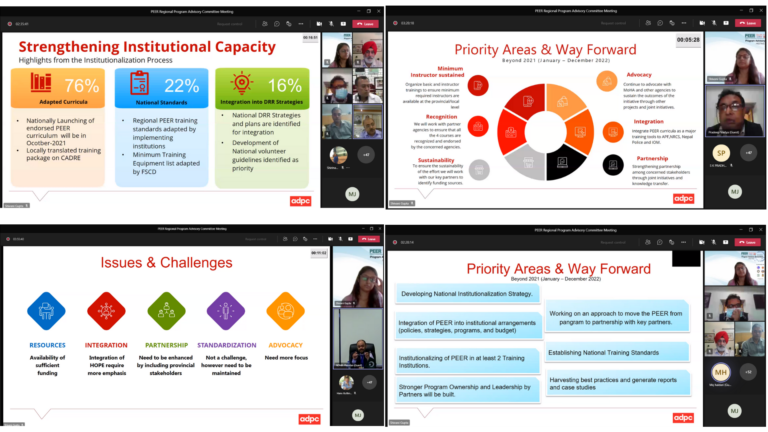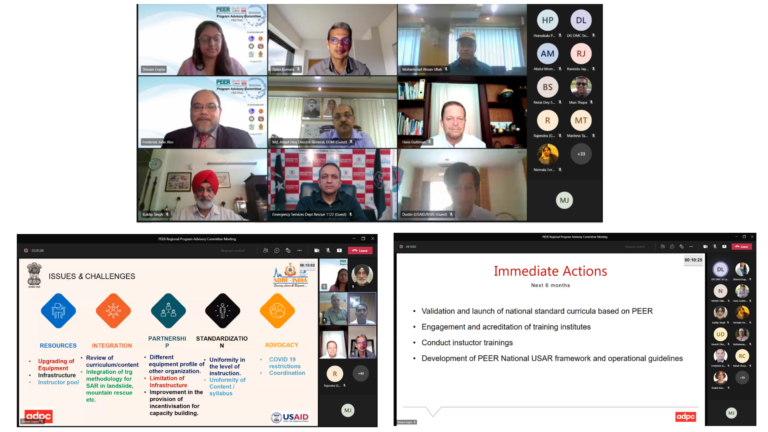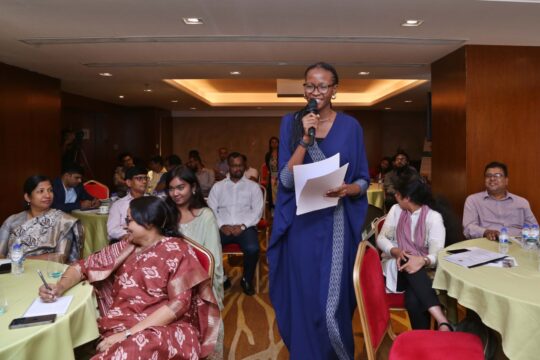The Program for Enhancement of Emergency Response (PEER) organized the Regional Program Advisory Committee (PAC) meeting on 4 August 2021. At the first PAC meeting, the discussions focused on the progress of PEER Institutionalization in program countries and deliberated a way forward to achieve institutionalization. Representatives from the National Disaster Management Authorities and other technical partners from Afghanistan, Pakistan, India, Bangladesh, Sri Lanka, and Nepal participated in the meeting.
The PEER member countries seek to collectively foster regional cooperation and develop a strategic approach to strengthen PEER institutionalization. Nodal agencies led the assessment of the current progress in the program countries using the Institutionalization Assessment Tool identified priority actions on the way forward to achieving this goal.
Unpacking Institutionalization
Mr. Dustin Shiau, Senior Regional Program Officer from the United States Agency for International Development Bureau for Humanitarian Assistance (USAID BHA), commended the stakeholders for their efforts towards institutionalization and explained how it will foster change through knowledge and stronger ownership by partners. He highlighted how these initiatives are unique as they seek to strengthen the emergency response systems at various levels that include policy and training.
Mr. Md. Atiqul Huq, Director General, Department of Disaster Management (DDM), Bangladesh, presented the country’s next steps to develop a high-level institutionalization working group and integrating PEER in Cyclone Preparedness Partnership (CPP) and the National Disaster Research and Training Institute (NDRTI) as well as other priority institutions’ annual performance plans.

Mr. Hans Guttman, Executive Director, Asian Disaster Preparedness Center (ADPC) emphasized the need for collaborative learning among the partner countries. He envisioned the future endeavors that would motivate data-driven progress, “We already have collected so much information from these six countries. Using this knowledge, we can assist our partners in shortening the learning process and enhance disaster reduction capabilities of the countries.”
Mr. S.K. Pradhan, Commandant, National Disaster Response Force (NDRF) presented the progress in India. He focused on the nation’s plan to upgrade the skills of NDRF personnel through a full-fledged course on Medical First Responders (MFR)-Collapsed Structure Search and Rescue (CSSR) and Community Action for Disaster Response (CADRE), replacing the bridge course which was previously planned. Dr. Pradeep Vaidya, Assistant Dean and Professor, Institute of Medicine in Tribhuvan University, Nepal, highlighted the lack of trainers in provinces in the country and upcoming plans to deploy more instructors in provinces beyond the urban region. Brigadier Waseem Uddin, Member (Operations) in National Disaster Management Authority (NDMA), Pakistan, also shared the strategy for going down to the provinces and districts to standardize PEER training at all levels.

Sri Lanka is the newest entrant in the PEER program. The state has achieved critical milestones in a short span of one year. Maj. Gen. Sudantha Ranasinghe, Director General of Disaster Management Center (DMC), Sri Lanka, expressed his pride in the level of progress of the country in the past year and moving forward to prioritize interventions for institutionalization. Even Afghanistan, being a new entrant, shared its progress. H.E. Mohammad Qaseem Haidari, Deputy Minister, Afghanistan National Disaster Management Authority (ANDMA), shared the priority areas to move forward and next steps to develop a national institutionalization strategy while focusing on embedding PEER in at least two training institutions.
Mr. Sisira Madurapperuma, Director, ADPC envisioned the next level of PEER institutionalization from the country level to the region, “We need to have one-on-one discussions with specific countries and take the regional technical working groups to move forward with our mission. The aim is to develop a PEER partnership simultaneously.”
Good Practices and Approaches on Institutionalization
Dr. Rizwan Naseer, Director General, Punjab Emergency Services Department (PESD) Rescue 1122, Pakistan, recalled how the ADPC team was present during the establishment of PEER training. He shared how the Emergency Services Academy has grown to incorporate simulations and practical training and shared a way forward by the accreditation of ESA training courses through PEER. Lt. Col. SM Zulfiker Rahman, Director (Training) in Fire Service and Civil Defense presented on their long-standing partnership with PEER since 2002 and explained how PEER’s knowledge and skills had been instrumental in rescue missions during the Spectrum Garment and Rana Plaza Collapse. He highlighted the national plan for establishing Banghabandhu Fire Academy and the integration of PEER courses in the proposed academy.
The discussion ended with identifying the priority areas which require attention to achieve the common objective of PEER institutionalization in partner countries. The key areas mentioned were:
- Establishing Regional Technical Working Groups
- Discussion on institutionalization with countries on a national level to engage wider stakeholders
- Finalizing the institutionalization assessment process which will act as a baseline for monitoring progress
- Developing action plans on priority areas identified by the nodal agencies and implementing institutions to enhance institutionalization based on the assessment.


